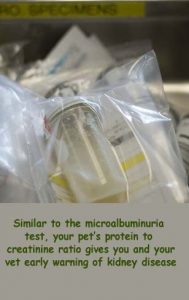Ron Hines DVM PhD
 See What Normal Blood & Urine Values Are
See What Normal Blood & Urine Values Are
 Causes Of Most Abnormal Blood & Urine Tests
Causes Of Most Abnormal Blood & Urine Tests
Your Pet’s Urine Protein:Creatinine Ratio = P:Cr, Pro:Creat In Your Pet’s Urine
One of the major problems in judging the amount of protein abnormally leaking into your pet’s urine due to kidney disease is that the amount varies depending on how much your pet drinks. The more it drank before you or your vet obtained the urine specimen, the more dilute the urine will be and the lower the protein content will be in each drop.
Creatinine is also eliminated in your pet’s urine. That is normal. (read here) The ratio of those two compounds, protein and creatinine, remains stable in dilute and concentrated urine. So determining the ratio between the protein and the creatinine lets your veterinarian adjust for the “diluteness” or “concentratedness” of the urine sample when judging the significance of spilled protein that the urine sample might contain.
The P:Cr test is not helpful when your pet is dehydrated, when the protein source is somewhere in the kidney structure itself, when the urine contains blood (visible to the eye or not), or when the pet has a urinary tract infection. It is also likely to be inaccurate if the urine contains large amounts of sediment.
Reasons Why Your Pet’s P:Cr ratio might be elevated:
All the same reasons for high urine protein content and microalbumin levels
High doses of corticosteroid medications can moderately increase your dog and cat’s protein:creatinine ratio.
Complementary Tests:
Complete urinalysis, BUN, blood Creatinine, microalbuminuria test, urine specific gravity, SDMA test
DxMe
 Dear reader, Besides your donations, Visiting the products that Google chooses to display on this webpage helps me pay the cost of keeping this article on the Web. As you know, sites like mine that are not designed to make money are getting harder and harder to find. Best wishes, Ron Hines
Dear reader, Besides your donations, Visiting the products that Google chooses to display on this webpage helps me pay the cost of keeping this article on the Web. As you know, sites like mine that are not designed to make money are getting harder and harder to find. Best wishes, Ron Hines


